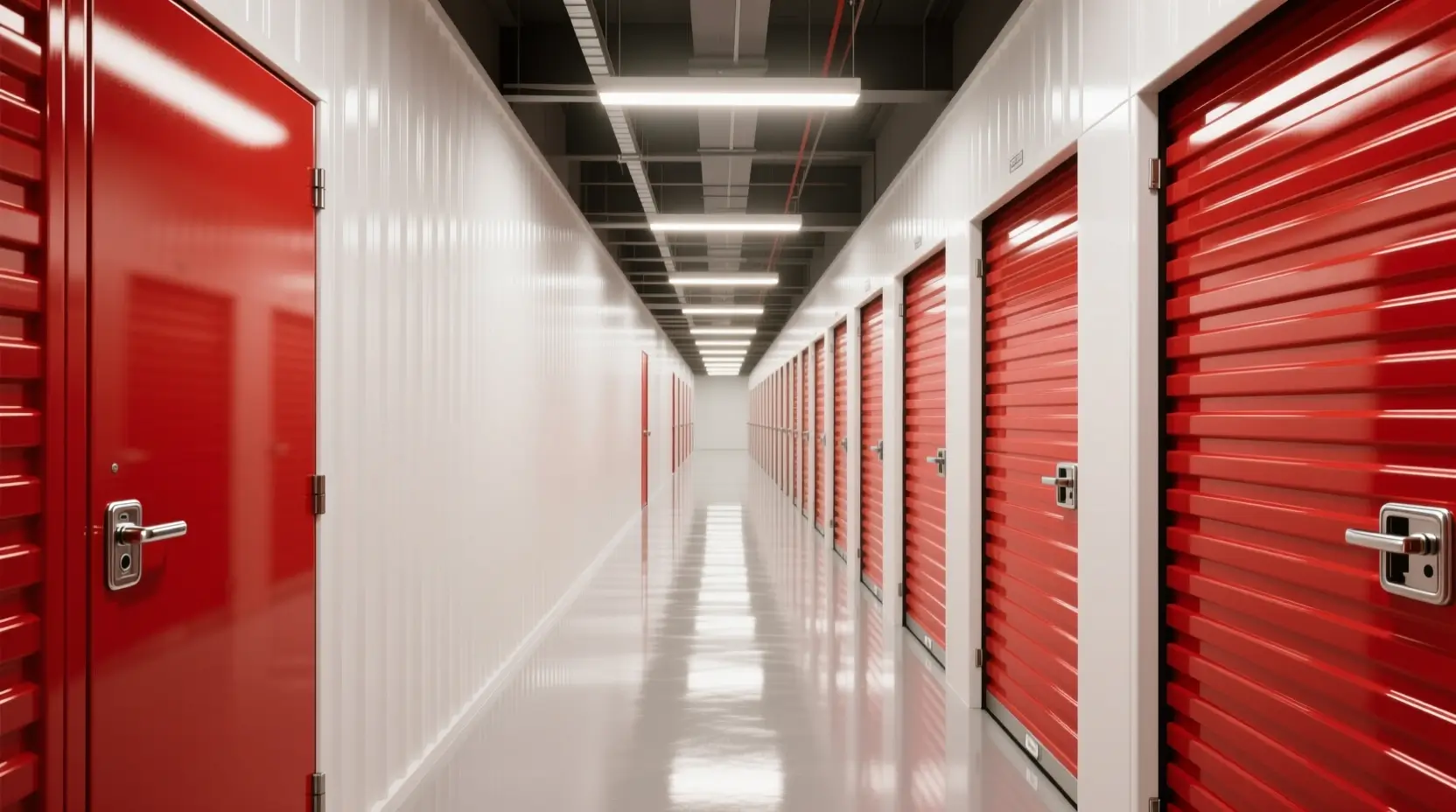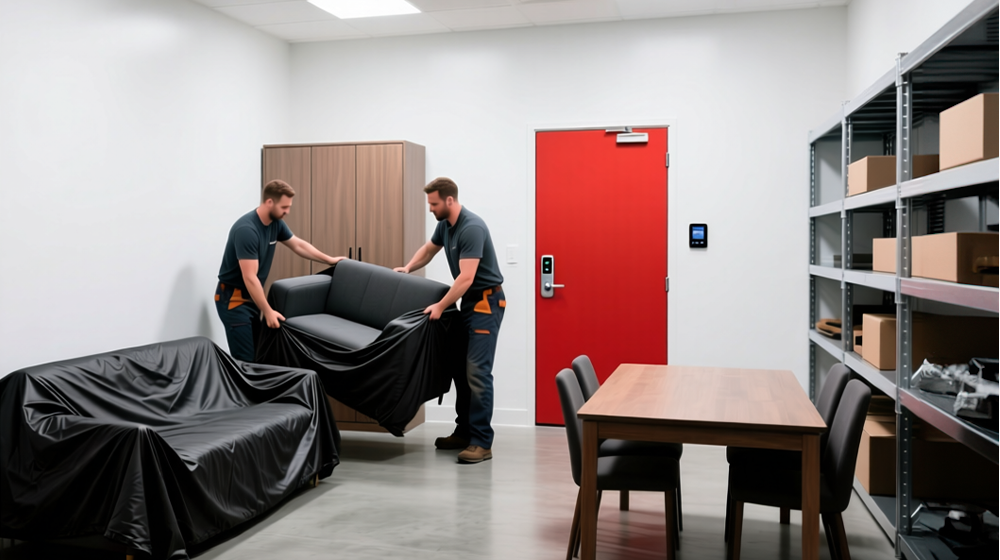Industrial and logistics rents in prime zones of Dubai and Abu Dhabi have surged markedly in recent quarters. In Q2 2025, warehouse rates in Abu Dhabi rose 22.4%, reaching AED 470 per square metre, while in Dubai, rates increased by ~19.9%, averaging AED 46 per square foot.
Demand is outpacing supply. Key industrial zones such as KEZAD in Abu Dhabi and Al Quoz, Dubai Investments Park, and Dubai South are experiencing tight vacancy and long waitlists. Self-storage demand in the UAE is responding accordingly. The UAE self-storage industry earned USD 602.5 million in 2024 and is forecast to reach USD 859.2 million by 2030, growing at a compound annual growth rate (CAGR) of approximately 6.3%. This article explores how industrial rent tightening leads to higher demand for self-storage: the mechanisms, relevant data, future forecasts, and what it means for businesses, consumers, and investors.
Industrial & Logistics Market Trends in Dubai & Abu Dhabi
Why Are Rents Rising?
Industrial and logistics rents in Dubai and Abu Dhabi have been climbing steadily because demand is growing faster than supply. According to the Knight Frank Industrial Market Review H1-2025, Grade-A rents in Al Quoz reached AED 85 per sq ft, which is about 31% higher than last year. Grade-B spaces in the same area are now AED 58 per sq ft, up roughly 21% year-on-year.
In Abu Dhabi, the trend is similar. Industrial hubs like KEZAD and Musaffah saw rents jump by 57% and 52% YoY, with Al Markaz reaching AED 375 per sq m. This shows that prime industrial areas across the UAE are experiencing intense rental pressure.
What Are Current Warehouse Rates?
The latest JLL UAE Industrial Market Dynamics Q2-2025 report highlights a broad rise in warehouse rents:
- Dubai: Average warehouse rents increased by 19.9% YoY, hitting AED 46 per sq ft.
- Abu Dhabi: Rents grew 22.4% YoY to AED 470 per sq m.
These increases are even higher in premium submarkets such as Al Quoz, Dubai Investments Park, and KEZAD, where location and connectivity add further value.
Why Is Supply So Limited?
Despite high demand, very few new Grade-A warehouses are being completed. JLL notes that developers are facing challenges like high land prices, long approval processes, and rising construction costs. As a result, many businesses are renewing their existing leases rather than moving, which keeps vacancy rates extremely low — often below 5% in prime zones.
Another important trend is the shift in occupier demand. Companies are now looking for mid-sized units (25,000–50,000 sq ft) rather than very large spaces, as this size offers better cost control and flexibility.
What Does This Mean for Businesses?
For companies in Dubai and Abu Dhabi, this market means less bargaining power and higher rental costs. Landlords are offering minimal incentives, so tenants must plan for higher OPEX and may consider alternatives like flexible storage solutions or self-storage units to handle overflow inventory or reduce reliance on long-term leases.
Key Drivers Behind Rising Industrial Rents
Understanding why industrial rents are rising helps explain why businesses are looking for alternatives like self-storage. Multiple structural and economic factors are creating upward pressure on rents across Dubai and Abu Dhabi.
Proximity and Accessibility Premium
Industrial zones with excellent port access, free zone status, and highway connectivity consistently command higher rents.
- Al Quoz remains in demand because it provides quick access to Sheikh Zayed Road and central Dubai.
- Dubai Investments Park (DIP) benefits from proximity to Expo City Dubai and Jebel Ali Port, making it a key logistics hub.
- KEZAD in Abu Dhabi is strategically connected to Khalifa Port and Etihad Rail’s future network, driving strong occupier interest.
E-Commerce and 3PL Growth
The rise of e-commerce is one of the biggest demand drivers.
- UAE’s e-commerce market is expected to surpass USD 17 billion by 2025 according to Statista, pushing more companies to secure last-mile delivery hubs and buffer storage facilities.
- 3PL (third-party logistics) providers are also expanding operations, leasing space closer to urban centers to meet same-day and next-day delivery commitments.

Construction and Land Cost Inflation
Landlords are facing higher costs for land acquisition, construction materials, and financing.
- Rising cement, steel, and labour prices mean that new Grade-A developments are more expensive to deliver.
- Developers pass these costs through higher rental rates to achieve acceptable yields.
This keeps average market rents on an upward trajectory even when new supply enters the market.
Government & Regulatory Support
Government initiatives are actively boosting demand.
- Abu Dhabi Industrial Strategy 2031 aims to increase the manufacturing sector’s contribution to GDP by AED 172 billion, encouraging new factories and industrial occupiers to expand within KEZAD and Musaffah.
- Free-zone policies and infrastructure investments (logistics corridors, warehousing clusters) make these zones more attractive, sustaining demand and reducing vacancy.
Summary of Drivers
When combined, these factors location advantage, booming e-commerce, cost inflation, and government-backed industrial growth create a strong upward pull on rents. Businesses that cannot absorb these increases are increasingly turning to self-storage facilities as a flexible, lower-commitment solution for overflow stock, seasonal inventory, and document storage.
Self-Storage Market Overview & Forecasts
What’s the current size of the UAE self-storage market?
According to Grand View Research, the UAE self-storage market generated approximately USD 602.5 million in revenue in 2024, and it is forecast to grow to USD 859.2 million by 2030, at a compound annual growth rate (CAGR) of around 6.3% through 2025-2030.
Which Unit Sizes Lead & Which Are Growing Fastest?
- In 2024, medium-sized storage units (neither very small nor very large) were the largest revenue-generating segment in the UAE self-storage market.
- The large unit size segment is expected to be the fastest growing between 2025-2030. This reflects increasing usage by SMEs, villa relocations, contractors, and people needing storage for larger items or inventory.
What’s Driving the Forecasted Growth?
- Rising e-commerce fulfillment demand and inventory storage needs are pushing up demand for larger storage units and more flexible lease lengths.
- Lifestyle changes: smaller apartments, frequent moving/relocating (especially among expats), renovations, and seasonal storage needs elevate demand for medium units.
- SMEs form a big part of the demand base: roughly 98% of companies in the UAE are SMEs, which often require storage for inventory, tools, and seasonal goods rather than long-term, large warehouse leases.
Key Trends to Watch
- Features like climate control, high security, flexible leasing, and online booking are becoming more important for both medium and large unit users.
- Real estate constraints and land costs continue to influence where new self-storage facilities can be developed. Zones closer to industrial and residential hubs are especially in demand.
- Operators who can cater to large units with quality service (good access, security, protection from climate) are likely to see higher growth.

Channels of Spill-Over: How Industrial Tension Affects Storage Demand
As industrial & logistics rents tighten, several channels spark increased demand for self-storage. These spill-over effects are already visible in the UAE market.
Inventory Overflow
When industrial warehouse space becomes too expensive or gets fully leased, small businesses and e-commerce sellers shift excess inventory, returns, and seasonal stock into self-storage units. According to Ruby Self-Storage Market Insights, warehouse rents in Dubai rose +19.9% YoY to AED 46 per sq ft, making large warehouse leases less viable for many SMEs. Self-storage offers flexibility and lower upfront capital.
Office-Adjacent Storage Needs
High office rents and fit-out costs are increasing, especially in prime zones. Businesses are offloading non-essential materials — archived documents, samples, displays — into self-storage units instead of expanding office or warehouse space. SMEs are heavily using office storage services to avoid capex and reduce recurring costs.
Residential & Lifestyle Changes
- Smaller living spaces: A growing number of 1-BHK and 2-BHK apartments in Dubai have limited in-home storage. Many residents face overcrowded homes, prompting off-site storage. ESelf Storage UAE – Unit Economics reports that many homes are now ~700-850 sq ft, increasing demand for external storage of furniture, décor, sports equipment, etc.
- Frequent relocation: High expat population leads to moves between emirates or between countries. Short-term storage becomes necessary during transitions.
- Climate-controlled features: Dubai’s extreme heat and humidity risk damage to electronics, paper items, and wood furniture. Self Storage reports that climate-controlled units are now a standard expectation for many storage users in the UAE.
Lease Flexibility
Because industrial leases are long term and costly to break, many businesses prefer self-storage, which offers flexible, short-term contracts. Self-storage lets companies scale up or down according to demand rather than committing to large, locked-in warehouse space. Businesses are comparing monthly self-storage costs vs fit-out/lease obligations and often find storage more predictable in uncertain markets.
Summary of Factors
| Driver | What Causes Changes in Storage Demand |
| Warehouses are expensive/full | Overflow inventory moves to self-storage |
| Office/fit-out cost is high | Businesses store non-core items off-site |
| Smaller homes & relocations | Residential users store more personal items |
| Heat & humidity concerns | Growing demand for climate-controlled units |
| Need for lease flexibility | Short-term, scalable storage is attractive vs. long industrial leases |
Impact on Pricing & Unit Utilization in Self-Storage
As industrial rents rise, self-storage pricing and how units are used are being tightly affected. Key trends include:
- Higher Rental Rates near Industrial Hubs
Self-storage operators located near industrial and logistics clusters are increasing their unit rates, especially for medium and large storage units, because users see additional value in reduced transport costs and convenience. For example, ESelf Storage UAE – Unit Economics of Climate-Controlled Self Storage reports that climate-controlled units near Dubai industrial zones are seeing increased occupancy and less turnover, reflecting the premium users attach to better storage amenities. - Higher Occupancy & Better Amenities Driving Utilization
Facilities that offer climate control, enhanced security, digital access, and better protection from heat and humidity record higher occupancy rates. Customers are willing to pay more for units that protect sensitive items. Storage providers also report reduced churn (fewer move-outs) for climate-controlled offerings. - Waitlists & Capacity Constraints in Prime Locations
Some well-located storage facilities, especially those offering premium features, are seeing capacity constraints or waitlists. Demand in zones adjacent to industrial clusters or major transport corridors is outpacing supply of quality units. While exact numbers are not always public, multiple facility operators report fully leased premium units. ESelf Storage UAE notes that climate-controlled units in desirable locations are being booked out faster, reducing availability for new customers.
Operator Strategies & Business Models Responding to Demand
To meet rising demand and counter cost pressures, self-storage operators are adapting in several ways:
- Differentiation through Premium Service Features
Operators are offering climate-controlled units, 24/7 security surveillance, smart entry/access control, and flexible lease terms to attract customers willing to pay higher rates for added peace of mind. These features set facilities apart from basic storage offerings. ESelf Storage UAE documentation shows climate control is now not just a luxury but a core offering in many new units. - Geographic Expansion to Lower-Cost Locations
To offset high land and rental costs in core areas, some operators are expanding into Northern Emirates (Sharjah, Ajman, Ras Al Khaimah) or other outlying areas where land is less expensive. This expansion allows lower-cost units for customers who prioritize price over proximity. The broader industrial trend of firms shifting operations to the Northern Emirates also supports the viability of storage businesses there. - Hybrid Models & Value-Added Services
Some operators are integrating storage with last-mile logistics or fulfillment services, or offering specialty storage (e.g. for metals, perishables, or oversized inventory). An example is the Metal Park Storage Hub in KEZAD, which offers specialised pay-as-you-go storage for the metal industry, with overhead cranes and loading bays, combining industrial storage and storage facility functions. - Tiered Pricing
Facilities are using price tiers: premium pricing in central or industrial-adjacent zones; lower pricing in remote or less accessible locations. Smaller units get lower rates; larger units with added features (security, climate control) command higher fees. This enables operators to address diverse customer segments while optimizing utilization.
Also read: The Unit Economics of Climate-Controlled Self Storage in Dubai: CAPEX, OPEX & 5-Year Payback
Regulatory, Infrastructure & Urban Planning Considerations
Several external factors outside operators’ control strongly influence storage market outcomes:
- Free Zones & Zoning Policies
Free zones in Abu Dhabi (KEZAD) and Dubai impact land availability, permits, and business regulations. Storage facilities located in or near free zones often benefit from better transport access and regulatory incentives. Regulatory support for industrial expansion increases demand pressure in adjacent zones. - Transport Infrastructure & Accessibility
Proximity to ports, major highways, and planned rail networks (like Etihad Rail) significantly boosts location value for both industrial users and storage customers. For example, the Metal Park Storage Hub in KEZAD offers direct access to highways, Khalifa Port, and connections out of Abu Dhabi, which is cited as a key advantage. - Data Transparency & Real Estate Information Access
Access to accurate real estate and transaction data supports better decision-making for both operators and customers. The Dubai Land Department’s Open Data portal provides indexes, transaction history, real-estate data, and research, helping companies assess land values, rental trends, and development potential.

Risks & Constraints for Self-Storage Expansion
Even with strong demand growth, several challenges could slow the pace of self-storage development in Dubai and Abu Dhabi:
- Land Cost & Acquisition Issues
Prime industrial and mixed-use land near logistics hubs is expensive and increasingly scarce. According to JLL, land prices in Al Quoz and Dubai South have increased along with rental rates, creating high barriers for new entrants. This forces operators to either pay premium prices or expand into secondary markets like Sharjah and Ajman. - High Operational Costs
Running a modern facility is expensive — especially climate-controlled facilities. ESelf Storage UAE highlights that climate control can account for 30–40% of total OPEX, due to air conditioning in UAE summers, electricity costs, and insulation requirements. Security systems, maintenance, and insurance add further overhead. - Regulatory & Zoning Constraints
Local zoning laws and free-zone restrictions may limit where new storage facilities can be built. Developers must navigate municipality approvals, fire safety compliance, and DEWA/ADD utility approvals before launch — a process that can take months. - Competition & Oversupply Risk
If too many operators launch facilities in the same submarket, rental rates could come under pressure. Oversupply can depress ROI, especially for premium facilities that require high occupancy to remain profitable.
What It Means for Businesses, Consumers & Investors
These trends carry practical implications for different market participants:
- For Businesses & SMEs:
Companies need to plan storage costs into their OPEX budgets and choose facilities close to their supply chain hubs to minimize transport time. Many SMEs are using self-storage as a cost-effective alternative to long-term warehouse leases. - For Consumers & Expats:
Self-storage is becoming a lifestyle service. Expats rely on it during relocations, renovations, and downsizing. Consumers also use storage for seasonal goods, furniture, or sports equipment in smaller apartments. - For Investors & Operators:
Self-storage is emerging as a high-performing real estate asset class in the UAE. Investors must assess location quality, unit mix (small, medium, large), and service level differentiation (climate control, 24/7 access, security) before entering the market. Under-served areas near industrial corridors or growing residential communities offer strong potential for yield.

Conclusion
Industrial and logistics rents in Dubai and Abu Dhabi are rising rapidly, driven by strong demand, limited new supply, and location advantages of prime industrial corridors. This tightness is directly spilling over into the self-storage market, where demand is increasing, occupancy is high, and pricing is climbing — particularly for climate-controlled and well-located facilities.
Verified forecasts show the UAE self-storage market growing from USD 602.5 million in 2024 to about USD 859.2 million by 2030, a CAGR of 6.3%.
For operators, businesses, and consumers, the key success factors will be:
- Choosing strategic locations near logistics and residential hubs
- Offering flexible, scalable unit options for SMEs and individuals
- Maintaining high service standards with climate control and security
- Navigating regulatory approvals and land constraints effectively
Those who anticipate these shifts and invest in premium, well-positioned facilities are most likely to benefit from the next growth phase of the UAE self-storage market.






